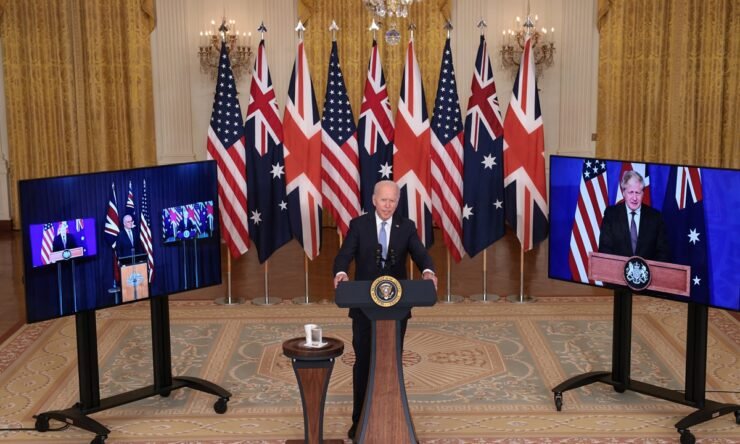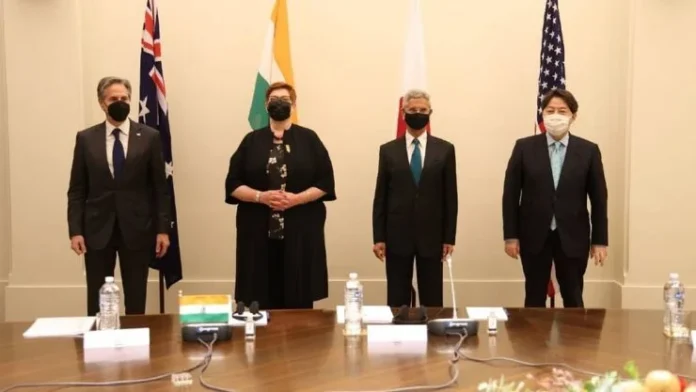The fourth Quad foreign ministers’ meeting attended by Australia, India, Japan and the US was held on February 11, 2022, in Melbourne. The main theme, as earlier, focused on a ‘Free and Open Indo-Pacific’, ‘Centrality of the ASEAN’ and ‘ASEAN Outlook on Indo-Pacific (AOIP), to which Indo-Pacific strategies of the EU and European countries were added.
Cooperation to address regional challenges, including humanitarian assistance and disaster response (HADR), maritime security, counter-terrorism, countering disinformation and cyber security were discussed.
Of particular significance was the discussion on terrorism, denouncing the use of terrorist proxies for cross-border terrorism and calling on all countries to ensure that territory under their control is not used to launch terror attacks and to expeditiously bring to justice the perpetrators of such attacks.
Special mention was made of the terrorist attacks in India including 26/11 Mumbai and Pathankot, and UNSC Resolution 2593 (2021) that Afghan territory should not be used to threaten or attack any other country.
The foreign ministers acknowledged the importance of sub-regional mechanisms and institutions, including in the Mekong sub-region, and affirmed support to Cambodia as the ASEAN Chair in 2022.
Combating the COVID-19 pandemic was emphasized together with delivery of the first batch of Quad-supported vaccines in the first half of 2022 and the initiative for coordinating response under a Global Action Plan for Enhanced Engagement.
Without naming China, the Quad foreign ministers opposed coercive economic policies and practices that run counter to this system. But this is what China has been doing and continues to do by debt-trapping 42 developing countries, including Laos, Papua New Guinea, the Maldives, Brunei, Cambodia and Myanmar.
China’s economic hold over Laos and Cambodia helps it to influence statements and decisions by ASEAN. The foreign ministers called on Myanmar’s military regime to implement ASEAN’s Five-Point Consensus and return Myanmar to democracy, and condemned North Korea for its ballistic missile launches in violation of the UNSC resolutions.
Japan’s Foreign Minister Hayashi Yoshimasa expressed serious concern over China’s unilateral attempts to change the status quo in the East and South China Seas through force and coercion. This, perhaps, and Ukraine was the reason behind the joint statement condemning unilateral attempts by some countries to change the status quo.
The US Secretary of State Antony Blinken spoke at length on Ukraine but not one word against China’s massive buildup against India and Chinese actions to change the status quo of the Line of Actual Control in Ladakh.
Concurrent to the Quad meet, the US released its ‘Indo-Pacific Strategic Report’ the same day, with a White House statement saying: “We will continue to build a strategic partnership in which the United States and India work together and through regional groupings to promote stability in South Asia; collaborate in new domains such as health, space, and cyberspace; deepen our economic and technology cooperation; and contribute to a free and open Indo-Pacific. We recognize that India is a like-minded partner and leader in South Asia and the Indian Ocean, active in and connected to Southeast Asia, a driving force of the Quad and other regional fora, and an engine for regional growth and development.”
The Strategic Report says Chinese coercion and aggression spans the globe, but it is most acute in the Indo-Pacific.
China is combining its economic, diplomatic, military, and technological might as it pursues a sphere of influence in the Indo-Pacific and seeks to become the world’s most influential power. Separately, a media report quoted an “anonymous” US official saying that “India faces very significant challenges. China’s behaviour on the Line of Actual Control has had a galvanizing impact on India. From our standpoint, we see tremendous opportunities in working with another democracy that understands the importance of the global commons.”
The above joint statement by the Quad may be considered a victory of Indian diplomacy because: It condemned the 26/11 Mumbai and Pathankot terror attacks; reiterated that Afghan territory will not be used to threaten or attack any country, shelter or train terrorists, or plan or finance terrorist acts, with such ungoverned spaces being a direct threat to the safety and security of the Indo-Pacific; opposed coercive economic policies and practices that run counter to this system without naming China, and; did not mention Russia and Ukraine.
China has been dismissing the Quad and AUKUS as “small cliques” perhaps because China views these groupings as US-led and the US policies under President Joe Biden are focused on Russia, lacking similar focus on China.

In October 2020, Biden told a news channel that Russia is the biggest threat to America and China the biggest “competitor”. The Biden administration failure to push through the Wuhan Virus probe, only stage a diplomatic boycott of the 2022 Beijing Winter Olympics and American pusillanimity in countering Chinese militarizing the East and South China Seas over decades, but raises questions about the quality of US response when China crosses the US red lines again.
America’s ‘Indo-Pacific Strategic Report’ says: “Our objective is not to change China but to shape the strategic environment in which it operates, building a balance of influence in the world that is maximally favourable to the United States, our allies and partners, and the interests and values we share.” But nations like China, Pakistan and North Korea are not bothered about rhetorical statements especially when Pakistan and North Korea are the nuclear talons of the Chinese dragon.
America’s repeated references to UNSC Resolution 2593 (2021) that Afghan territory should not be used to threaten or attack any country, shelter or train terrorists, or plan or finance terrorist acts, with such ungoverned spaces (as also mentioned in joint statement of the Quad) is a big joke after having handed over Afghanistan on a platter to Taliban—among the top five terrorist organizations in the world.
Pakistan remains a major non-NATO ally of the US. Despite its double game in Afghanistan, the US still believes it can use Pakistan to tackle the Taliban and China. This is despite US scholars recommending to the blind men of Capitol Hill to change their policy towards Pakistan, not just stoppage of military aid, even as funds from various organizations in the US to indirectly boost terrorism in Pakistan continue unabated.
In January 2020, then US President Trump held a meeting with Pakistani Prime Minister Khan (third meeting between the two countries) on the sidelines of the World Economic Forum in Davos, where Trump said the growing relationship between the US and Pakistan has never been closer with Pakistan than it is currently under his administration. Trump once again offered to mediate on the Kashmir issue, which was welcomed by PM Khan.
Chinese President Xi Jinping is on a roll buoyed by Washington’s fixation on Russia. China has had its way with the biological bombing of the world, killing democracy in Hong Kong and is backing the military regime in Myanmar.
US sanctions on Myanmar are pushing the nation more into China’s sphere of influence that adversely affects India-Myanmar relations, even as India goes along the Quad despite being the only Quad nation sharing a land border with Myanmar which has strategic implications for India’s Act East Policy (AEP).
No doubt India needs American technology but the US equally needs Indian markets and to counter China, even though the US may view an India-China war advantageous to furthering its economic and strategic interests. But as far as the Quad goes, America’s focus is clearly on the Western Pacific and in using India’s maritime capabilities in the Indo-Pacific. If that was not so, why only joint maritime exercises of the Quad—why not at least discuss joint army and air exercises in, say Ladakh or Arunachal Pradesh to message China?
(The author is a veteran of the Indian Army. Views expressed are personal)
The author is an Indian Army veteran. The views expressed are of the author and do not necessarily reflect the views of Raksha Anirveda






